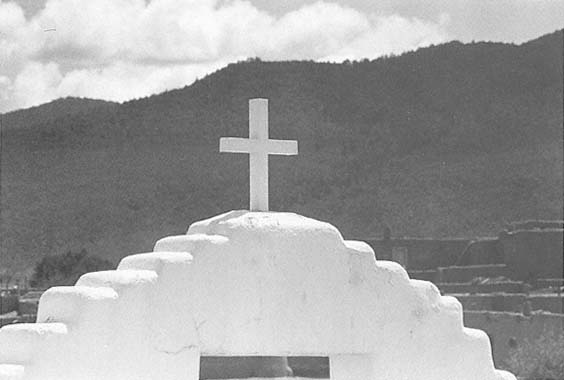ACKNOWLEDGMENTS
It has been said that any writing stands at the tip of a pyramid supported by the work of other scholars. This book is no exception. Certain of these authors are credited in the introduction; the bibliography lists others. To begin, I must mention John Brinckerhoff Jackson, a close friend and inspiration, whose exact profession eludes classification. He is a scholar, an author, a geographer, and a historian of the American cultural landscape. Today he likes to say that he has retired to his home in La Cienaga, although this is far from the truth. As the founder, publisher, and editor (for seventeen years) of Landscape magazine, he has had an enormous impact on thought in the field and has given many a knowledgeable personal view of the Southwest. While claiming no expert knowledge of the subject of New Mexican religious architecture, he has been highly influential to my view of the subject in conversation and criticism; as the contributor of the Foreword to this book, he has provided additional insight. For both I am extremely grateful.
I was also fortunate to have had the opportunity to meet Bainbridge Bunting, whose books and articles constitute the most succinct explanation of the state's architecture, including the colonial period church. When I first met him at a gathering of the Society of Architectural Historians some years ago, I suggested timidly that I was thinking of writing a book on his subject, and he warmly encouraged me in the undertaking. His untimely death deprived New Mexico of its strongest architectural advocate.
Several of my colleagues at the University of California, Berkeley, especially Professors Spiro Kostof and Dell Upton, graciously reviewed the text in manuscript form and offered valuable suggestions for improving it. Architectural historian Christopher Wilson also contributed critical insight, comments, and help with source materials. Robert Nestor, who is primarily responsible for my interest in the architecture of New Mexico, provided not only material on the churches on which his firm has worked but also valuable information on their history and construction.
Several other scholars, including George Kubler, Marc Simmons, John Kessell, E. Boyd, and D. W. Meinig, have contributed unknowingly to this text. Their many works on social and political history,
geography, popular arts, and architecture are cited in the bibliography and are recommended as further reading.
Even during the century that photography has documented the effects of environment and society on the earthen churches, the changes have been great, and the photographic records are critical to our understanding of their environment and architectural form. I must thank Arthur Olivas and Richard Rudisill, photo archivists at the Museum of New Mexico, for their help and advice. It was a pleasure to work with two people so knowledgeable about their institution's collections. Sanda Alexandride, the former archivist at the Heye Foundation, Museum of the American Indian, was helpful in locating and having printed certain images of ceremony on Pueblo lands. I also thank James Ivey, historian with the National Park Service, who provided base plans of the Salinas missions and shared his recent archaeological findings and interpretations. McHugh-Lloyd and Associates, Architects, also loaned drawings from which several of the plans were prepared. In addition to the Museum of New Mexico, the National Park Service, the Smithsonian Institution, and the Tourism and Travel Division of the State of New Mexico have generously permitted reproduction of their photographs.
The Bancroft Library at the University of California, Berkeley, has proved an invaluable resource. I also wish to acknowledge the aid of Laura J. Holt, librarian at the Laboratory of Anthropology in Santa Fe, and Jan Barnhart, librarian of Special Collections including the John Gaw Meem Archives at the Zimmerman Library, University of New Mexico, for their help in tracking both obvious and obscure information. Sarah Nestor, formerly editor at the Museum of New Mexico Press, deserves my gratitude for helping initiate and encourage this project.
To Jean Sugiyama, Jan Kristiansson, and especially Barbara Ras, go my gratitude for making the task of editing both challenging and bearable. The text is all the better due to their efforts. Steve Renick generously lent his design expertise and criticism.
For research assistance, thanks go to Diane Favro, currently teaching at the University of California, Los Angeles. Her ability to track and find the difficult fact is an innate gift. Credit is also due to two people who helped produce the manuscript: Sylvia Russell and D'vora Treisman. Kevin Gilson printed most of the photographs from my negatives, getting the best from what they offered. heather Trossman helped develop the original graphic vocabulary for the plans, although Dorothée Imbert executed all the plans and other drawings and aided me in the final library searches and the last-minute rushes to the Bancroft Library to track the elusive footnote. Her help and encouragement have been crucial to the completion of the book; her sense of humor helped me maintain my own during some trying situations.
Portions of this work were aided by grants from the Committee on Research, University of California at Berkeley. I would also like to acknowledge the gracious support for color reproductions provided by The Program for Cultural Cooperation Between Spain's Ministry of Culture and the United States Universities.

San Jerónimo
Taos pueblo
Entry portal.
[1986]